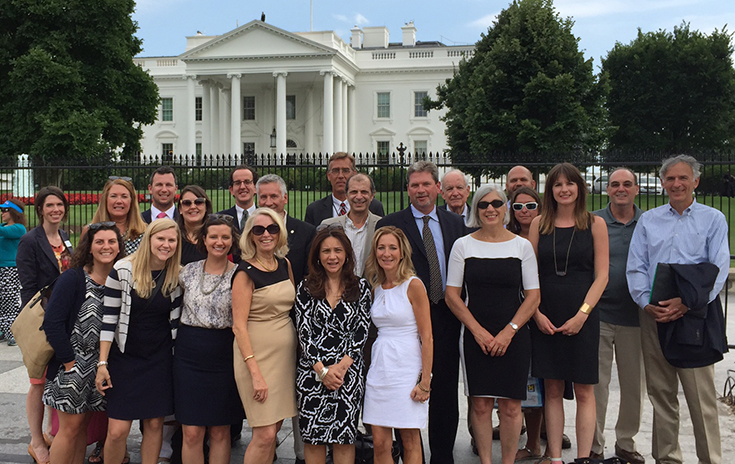Mid-Atlantic Ocean Users Tell Congress to Support the New Ocean Action Plan
Published by Ocean Conservancy
What do recreational fishermen, research scientists, commercial shipping representatives, conservationists and renewable energy developers have in common? They’ve all come together at a common table to address important decisions being made about our ocean thanks to ocean planning.
Two weeks ago, over 20 ocean users from the five Mid-Atlantic states came to Washington, D.C., to talk about the recently released Mid-Atlantic Ocean Action Plan with Members of Congress and the National Ocean Council at the White House.
These individuals came to D.C. with a simple message: the Mid-Atlantic Ocean Action Plan was released July 5th, and it will provide real benefits to our ocean, the states, and ocean industries. It offers a seat at the decision-making table for ocean users across the region and seeks to proactively identify ocean uses and resolve conflicts before they become problematic. They asked members of Congress to support the plan, and to support their respective industries’ roles in the planning process.
Over the course of two days, these ocean users met with 36 members of Congress and the National Ocean Council to talk about the benefits smart ocean planning has brought to the region and will continue to bring. This visit was a celebration of the hard work the region has put in to the planning process, and also a chance to discuss with federal leaders the significance of this ocean plan. They requested support for the Mid-Atlantic Ocean Action Plan and the efforts of ocean users like themselves who have been invested in this collaborative process with the goal of making better, more informed ocean use decisions.
What did the Participants Have to Say?
What were some of the takeaways for the people who came down from the region, and what does planning mean to different ocean sectors? Check out what some of the individuals that attended the D.C. fly-in last week had to say:
“It used to be that if we wanted to address an issue we, as fishermen, had to go to each agency individually: Coast Guard, Department of Defense, National Oceanic and Atmospheric Administration, and Bureau of Ocean Energy Management, and often we were left out of discussions. Ocean planning gives us a platform to participate in these discussions—this is an absolutely wonderful idea. We’ll be able to comment early in the process on vital issues regarding fishing and habitat. We’ll be able to address emerging issues such as the impacts of climate change on fishing and sand mining.”
— Jeff Deem, a recreational fisherman who serves on the Stakeholder Liaison Committee with the Mid-Atlantic Regional Council on the Ocean and the Mid-Atlantic Regional Planning Body.
“Before ocean planning the recreational boating industry was ‘invisible’ to state and federal resource managers. But we represent 185,000 registered recreational boats in Maryland. When I was learning to sail in the Chesapeake a container ship captain once told me your little sailboat is invisible to me, don’t get close to me because I can’t see you. As a recreational fisherman you may have an idea where you want to fish that day, but the fish move, so the recreational boats move. Having this one-stop-shop data portal is vital because we can see where the ships are going.”
— Susan Zellers, Executive Director of the Marine Trades Association of Maryland
“Ocean planning is the most efficient and cost-effective platform for balancing commerce and conservation. It provides stakeholders an opportunity to identify their use of the ocean common grounds, while seeing how other uses might impact their activity. Through ocean planning, any potential conflicts can be identified and diffused.”
— Carleen Lyden-Kluss, Executive Director of New York Maritime, Inc.
“Ocean planning is good business. What any business investor looks for is a way of reducing risk and increasing the probability that the project will go through. Ocean planning brings stakeholders together and reduces risks and increases certainty. We know we’re not the only kid on the block. We are committed to siting windfarms responsibility. We want to share our project plans and data, vet and test projects before other ocean users. We want their feedback. Ocean planning gives us the forum to do that.”
— Paul Rich, Director of Project Development at U.S. Wind
“Commercial shipping is undergoing an extremely dynamic period of change. We’re seeing global market fluctuation, larger ships, regulation, and growing commerce coupled with port and canal expansions. All these influences combined continually change routes and operations. Our members value ocean planning because it gives them a voice in decision-making and the opportunity to work together through agency commitments outlined in the ocean plans. We have already seen the benefits of this collaboration in the Northeast and Mid-Atlantic.”
— Sean Kline, Director of Maritime Affairs at the Chamber of Shipping of America.
What’s Next?
On July 5th, the Mid-Atlantic Regional Planning Body (RPB) released the draft Mid-Atlantic Ocean Action Plan. They will welcome comments for 60 days, through September 6th. We encourage you to check out our blog on the plan release, and read through the plan for yourself! If you are inspired, we also encourage you to submit your comments on the plan.
Learn more about the Mid-Atlantic ocean planning process at the RPB’s website and their Regional Ocean Assessment, a great resource they put together during the planning process.
Read the full article at: http://blog.oceanconservancy.org/2016/07/26/mid-atlantic-ocean-users-tell-congress-to-support-the-new-ocean-action-plan/



